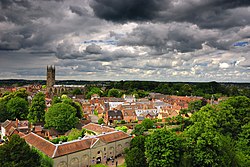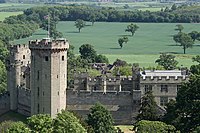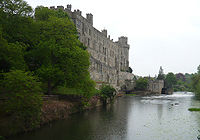Warwick
| Warwick | |
| Warwickshire | |
|---|---|
 A view over Warwick | |
| Location | |
| Grid reference: | SP2865 |
| Location: | 52°16’48"N, 1°35’24"W |
| Data | |
| Population: | 25,434 |
| Post town: | Warwick |
| Postcode: | CV34, CV35 |
| Dialling code: | 01926 |
| Local Government | |
| Council: | Warwick |
| Parliamentary constituency: |
Warwick and Leamington |
Warwick is a historic market town in Warwickshire, of which it is the county town. Warwick stands on the River Avon, 11 miles south of Coventry and 2½ miles west of Leamington Spa, with which town it has grown together.
The centre of Warwick stands on a hill which drops sharply down to the river. The Castle stands beside the river and is the main visitor attraction.
The town centre is also known for its historic architecture and contains a mixture of Tudor and 17th-century buildings. The wealth of historic buildings in the town and the tangled old lanes give it a charm and grandeur accentuated by its most famous and visited landmark; Warwick Castle.
In recent years several high-profile national and international companies have set-up large office complexes in and around Warwick.
Contents
Warwick Castle
Warwick Castle sits on a bend on the River Avon. It was built by William the Conqueror in 1068 within or adjacent to the Anglo-Saxon burh of Warwick and was used as a fortification until the early 17th century
From 1088, the castle traditionally belonged to the Earl of Warwick, and it served as a symbol of his power. The castle was taken in 1153 by Henry of Anjou, later Henry II. It has been used to hold prisoners, including some from the Battle of Poitiers in the 14th century. Under the ownership of Richard Neville – also known as "Warwick the Kingmaker" – Warwick Castle was used in the 15th century to imprison the English king, Edward IV.
Since its construction in the 11th century, the castle has undergone structural changes with additions of towers and redesigned residential buildings. Originally a wooden motte-and-bailey, it was rebuilt in stone in the 12th century. During the Hundred Years' War, the facade opposite the town was refortified, resulting in one of the most recognisable examples of 14th century military architecture.
In the early 17th century, the owner Sir Fulke Greville determined to convert the castle into a country house. The grounds were turned into a garden. Later in the century, in the 1640s under Robert Greville, 2nd Baron Brooke, the castle's defences were enhanced to prepare the castle for action in the English Civil War. Greville was a Parliamentarian, and Royalist forces laid siege to the castle. Warwick Castle withstood the siege and was later used to hold prisoners taken by the Parliamentarians.
The Greville family became Earls of Warwick in 1759, and owned the castle until 1978. In that year the Tussauds Group purchased Warwick Castle and opened it as a tourist attraction. It is protected as a Scheduled Ancient Monument and a Grade I listed building.
Sights of the town
- Market Hall
- Warwick Castle
- Lord Leycester hospital
- Warwick School
- Guy's Cliffe House
- Warwick Hospital, Lakin Road
- Lord Leycester hotel
- Collegiate Church of St Mary
- The Dream Factory
- Saxon Mill
- St. Nicholas' Park
- St John's Museum
- Bridge House Theatre
The Grand Union Canal and the River Avon pass through the town. The restored Saltisford Canal Arm, is close to the town centre, and is a short branch of the Grand Union Canal. The arm is the remains of the original terminus of the Warwick and Birmingham Canal and dates back to 1799. The Saltisford Canal Trust have restored most of the surviving canal, which is now the mooring for colourful narrowboats and a waterside park open to the public. Over 800 visiting narrowboats come by water to Warwick each year and moor on the arm.
History
Anglo-Saxons
According to the Anglo Saxon Chronicle, Warwick was founded on the banks of the River Avon in the year 914 AD when Æthelflæda Lady of the Mercians, sister of King Edward the Elder of Wessex and widow of Ealdorman Aethelred, built a fortigied burh to overwhelm the Danes who had settled in what had been the old Mercian kingdom. She was the. This burh was the predecessor of Warwick Castle.[1] The name 'Warwick' means "village by the weir".
Its fortifications led Warwick to become the centre of a new shire; Warwickshire.
Swegn and Canute
In 1050, the Danes burned down much of Warwick including the nunnery (which stood on the site of the present day St Nicholas Church).[2]
Later Middle Ages
In mediæval times, Warwick remained under the control of various Earls of Warwick, mostly of the Beauchamp family, becoming a walled town. Today the only remains of the town walls are the east and west gatehouses. The eastern gatehouse now serves as part of the King's High School, a sister institution to Warwick School. Warwick was not incorporated as a borough until 1545.[2] The town's Priory was founded in 1142 on the site now occupied by Priory Park.
During the English Civil War the town and castle were garrisoned for Parliament. The garrison, under Sir Edward Peyto, withstood a two-week siege by the Royalists. Later musters from 1644 to 1646 record a garrison of up to 350 men under the command of Colonel William Purefoy and Major John Bridges.
The middle of the 17th century also saw the founding of Castle Hill Baptist Church, one of the oldest Baptist churches in the world.
Fire
In the Great Fire of Warwick of 1694, much of the mediæval town was destroyed [3] As a result, most of the buildings in the town centre are of late 17th and early 18th century origin, although a number of older mediæval timber-framed buildings survive, especially around the edges of the town centre.[1]
The fire burnt down much of the mediæval Church of St Mary; both the chancel and the Beauchamp Chapel, however, survived, the latter having been built between 1443 and 1464 according to the wishes of Richard Beauchamp, Earl of Warwick (who had died in Rouen in 1439). A full size reclining copper gilt effigy of the Earl lies upon his Purbeck marble tomb - a fine piece of mediæval metalwork cast in 1459.
Education
Warwick School
Warwick School is an independent school for boys, which claims to be the oldest boys' school in England. The actual date of its founding is unknown, although 914 has been quoted in some cases. For some years the school honoured the fact that King Edward the Confessor (c.1004–1066) chartered it, although there is no direct evidence for this, and King Henry VIII re-founded the school in 1545.
Whatever the truth of the matter, there is no doubt that there has been a grammar school in the town of Warwick since before the Norman Conquest, and its successor, the present independent school, has been on its current site south of the River Avon since 1879.
University of Warwick
The University of Warwick is named not after the town but after Warwickshire, and it main centre is on the outskirts of Coventry. It does however maintain a campus now in Warwick.
Culture
Warwick hosts annual festivals ranging from the Spoken Word to Classical and Contemporary Music to a Folk Festival and a Victorian Evening, held in late November or early December.
St Mary's Church hosts a series of Early Music concerts.[1] The Bridge House Theatre hosts the "Music-in-Round" concerts.[2]
Warwick Chamber of Trade helps to promote the town for visitors, residents and businesses.
Warwick is also known for Warwick Racecourse, near the west gate of the mediæval town, which hosts several televised horse racing meetings a year.
References
- ↑ 1.0 1.1 Allen, Geoff, (2000) Warwickshire Towns & Villages, ISBN 1 85058 642 X
- ↑ 2.0 2.1 Terry Slater (1981) A History of Warwickshire, ISBN 0-85033-416-0
- ↑ The governing charter of the borough of Warwick p.51 Joseph Parks (1827)
Outside links
- Building History entry for Warwick
- Warwick Chamber of Trade
- Enjoy Warwick - An invaluable reference to the unspoilt town of Warwick
- Warwickshire's Railways — the history of the county's railways from 1838 to 1968
- Warwick Tourist Information Centre
- A collection of photographs of Warwick
- Saltisford Canal Trust: Warwick's local waterway charity
- Photos of Warwick and surrounding area on geograph







